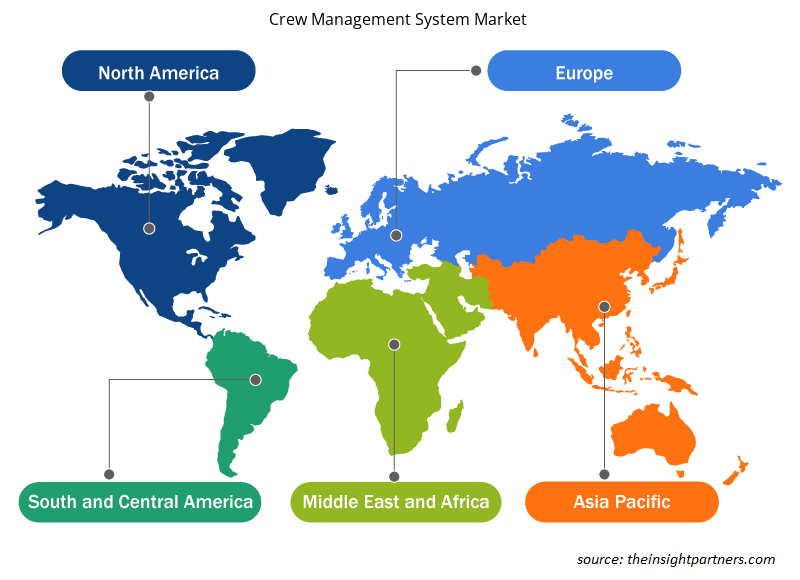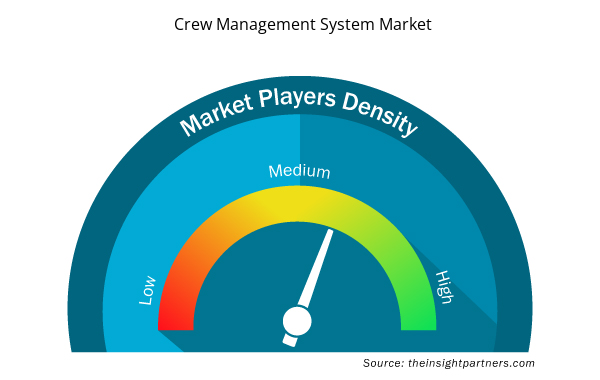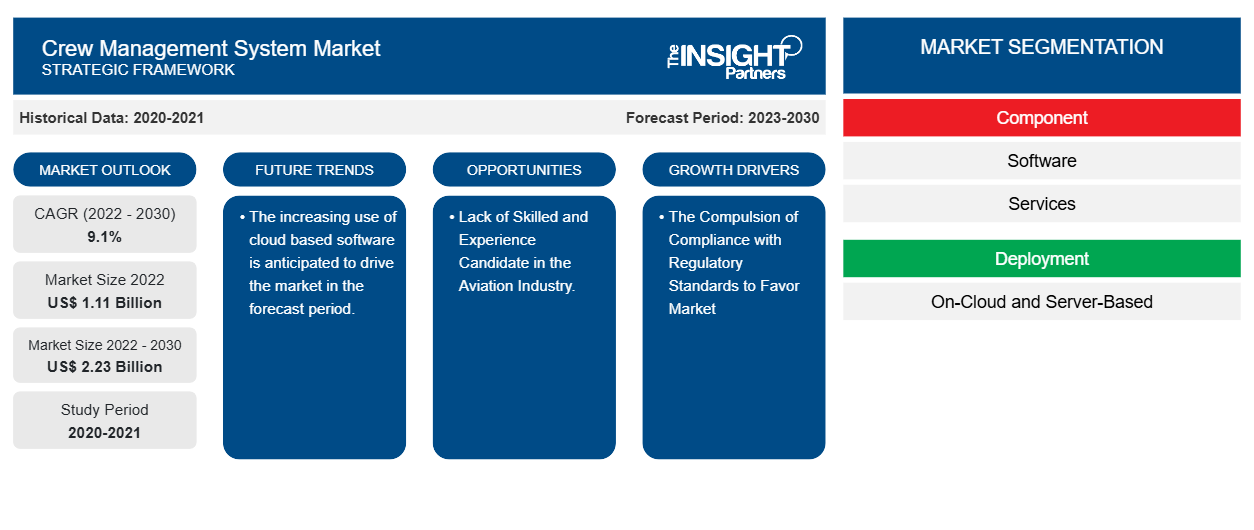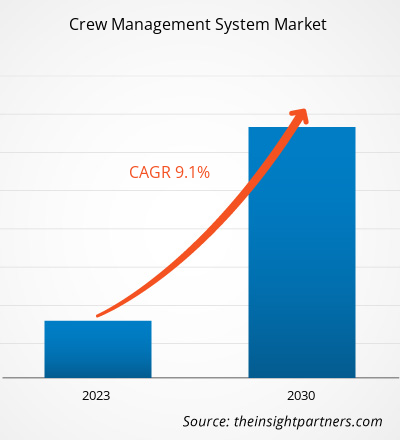乗務員管理システムの市場規模は、2022年の11億1,000万米ドルから2030年には22億3,000万米ドルに達すると予測されています。市場は2022年から2030年の間に9.1%のCAGRを記録すると予想されています。航空業界の急速な成長と効率的な乗務員管理ソリューションに対する需要の高まりは、市場の主要なトレンドであり続けると思われます。
乗務員管理システム市場分析
規制基準への準拠義務の増大と航空業界の急速な成長に伴い、乗務員管理システム市場の需要は増加すると予想されています。さらに、効率的な乗務員管理ソリューションに対する需要の高まりが市場の成長を後押ししています。さらに、低コストの長距離フライトの拡大と航空業界における熟練した経験豊富な候補者の不足は、市場に大きなチャンスをもたらします。
乗務員管理システム市場の概要
乗務員管理システムは、乗務員に関する情報を常に提供することを目的としています。このシステムは、乗務員がホームステーションまたはアウトステーションにいるかどうかに関する情報を提供し、乗務員のステータス記録を維持し、列車に乗務員を割り当てる際にユーザーを支援します。また、定期休憩やその他の休憩、道路学習、牽引知識、トレーニング スケジュール、PME、DAR アクションなどに関する情報も維持します。
要件に合わせてレポートをカスタマイズする
このレポートの一部、国レベルの分析、Excelデータパックなど、あらゆるレポートを無料でカスタマイズできます。また、スタートアップや大学向けのお得なオファーや割引もご利用いただけます。
- このレポートの主要な市場動向を入手してください。この無料サンプルには、市場動向から見積もりや予測に至るまでのデータ分析が含まれます。
乗務員管理システム市場の推進要因と機会
市場を有利にするための規制基準遵守の強制
航空会社やその他の航空輸送会社の最優先事項は、運航規則の遵守を保証することです。乗務員の飛行時間、休憩時間、勤務を管理する複雑な規則や規制があるため、乗務員のスケジュールは規制遵守プロセスの重要な側面です。乗務員のスケジュール システムは、違反やそれに伴う罰則のリスクを軽減することで、これらの法律の遵守を確認する上で重要な役割を果たします。また、コンプライアンスもあり、乗務員管理ソフトウェアは、訓練、資格、当直の基準に関する国際条約 (STCW) や海上労働条約 (MLC) などの関連する国際海事規制の遵守を確実にするのに役立ちます。したがって、規制基準への遵守の強制が市場の成長を促進します。
航空業界における熟練した経験のある候補者の不足。
航空業界では熟練した経験豊富な候補者が不足しており、乗務員管理システム市場には多くのチャンスがあります。熟練した候補者が少ないため、航空会社は既存の従業員の生産性と効率を最大化する必要があります。乗務員管理システムは、乗務員のスケジュールを最適化し、利用可能な人材を効果的に活用し、ダウンタイムを減らし、全体的な運用効率を向上させるのに役立ちます。また、トレーニングおよび開発ツールの強化、採用プロセスの改善、既存の人材の維持、コンプライアンスおよび安全管理などにも役立ちます。
乗務員管理システム市場レポートのセグメンテーション分析
乗務員管理システム市場分析の導出に貢献した主要なセグメントは、コンポーネント、展開、航空会社の種類、およびアプリケーションです。
- コンポーネントに基づいて、乗務員管理システム市場はソフトウェアとサービスに分かれています。ソフトウェアセグメントは、予測期間中に大きなシェアを占めると予想されます。
- 導入に基づいて、乗務員管理システム市場はクラウドベースとサーバーベースに分けられます。クラウドベースのセグメントは、予測期間中に大きなシェアを占めると予想されます。
- 航空会社の種類に基づいて、乗務員管理システム市場は、旅客航空会社と貨物・防衛航空会社に分かれています。旅客航空会社セグメントは、予測期間中に大きなシェアを占めると予想されます。
- アプリケーション別に見ると、市場は乗務員業務と乗務員訓練に分類されます。乗務員業務セグメントは、予測期間中に大きなシェアを占めると予想されます。
地域別乗務員管理システム市場シェア分析
乗務員管理システム市場レポートの地理的範囲は、主に北米、アジア太平洋、ヨーロッパ、中東およびアフリカ、南米および中米の 5 つの地域に分かれています。
北米は乗務員管理システム市場を独占してきました。この成長は北米の技術進歩によるものです。AIやMLなどの技術の統合により、乗務員管理システムの効率と機能性が向上しています。さらに、デジタル化、研究開発への重点が北米の市場成長を後押ししています。さらに、クラウドベースのソリューション、規制遵守と運用効率、戦略的パートナーシップと投資へのシフトが進み、乗務員管理ソフトウェア市場が牽引されています。
乗務員管理システム市場の地域別分析
予測期間を通じて乗務員管理システム市場に影響を与える地域的な傾向と要因は、Insight Partners のアナリストによって徹底的に説明されています。このセクションでは、北米、ヨーロッパ、アジア太平洋、中東、アフリカ、南米、中米にわたる乗務員管理システム市場のセグメントと地理についても説明します。

- 乗務員管理システム市場の地域別データを入手
乗務員管理システム市場レポートの範囲
| レポート属性 | 詳細 |
|---|---|
| 2022年の市場規模 | 11億1千万米ドル |
| 2030年までの市場規模 | 22億3千万米ドル |
| 世界のCAGR(2022年 - 2030年) | 9.1% |
| 履歴データ | 2020-2021 |
| 予測期間 | 2023-2030 |
| 対象セグメント | コンポーネント別
|
| 対象地域と国 | 北米
|
| 市場リーダーと主要企業プロフィール |
|
乗務員管理システム市場のプレーヤー密度:ビジネスダイナミクスへの影響を理解する
乗務員管理システム市場は、消費者の嗜好の変化、技術の進歩、製品の利点に対する認識の高まりなどの要因により、エンドユーザーの需要が高まり、急速に成長しています。需要が高まるにつれて、企業は提供を拡大し、消費者のニーズを満たすために革新し、新たなトレンドを活用し、市場の成長をさらに促進しています。
市場プレーヤー密度とは、特定の市場または業界内で活動している企業または会社の分布を指します。これは、特定の市場スペースに、その規模または総市場価値と比較して、どれだけの競合相手 (市場プレーヤー) が存在するかを示します。
乗務員管理システム市場で事業を展開している主要企業は次のとおりです。
- エイムズインターナショナルDWCLLC
- エアバスSE
- アルコスLLC
- CAE株式会社
- ヒティットコンピュータサービス株式会社
- IBS ソフトウェア株式会社
免責事項:上記の企業は、特定の順序でランク付けされていません。

- クルー管理システム市場のトップキープレーヤーの概要を入手
乗務員管理システム市場のニュースと最近の動向
乗務員管理システム市場は、主要な企業出版物、協会データ、データベースなどの一次調査と二次調査後の定性的および定量的データを収集することによって評価されます。乗務員管理システム市場におけるいくつかの開発を以下に示します。
- エア・インディアは、勤務シフトのルールを強化し、予定されていた運航中断からの迅速な回復を可能にする新しい乗務員管理システムを近々導入すると発表した。
(出典:エア・インディア、同社ウェブサイト、2024年4月)
- OSM と Ocean Technologies Group は、船隊、乗組員、学習管理全体にわたる運用支援を提供するための戦略的パートナーシップを結びました。大手船舶管理会社 OSM は、長期的なデジタル戦略をさらに強化するために、Ocean Technologies Group (OTG) と戦略的パートナーシップを締結しました。
(出典:OSM、企業ウェブサイト、2022年4月)
乗務員管理システム市場レポートの対象範囲と成果物
「乗務員管理システム市場規模と予測(2020〜2030年)」レポートでは、以下の分野をカバーする市場の詳細な分析を提供しています。
- 対象範囲に含まれるすべての主要市場セグメントについて、世界、地域、国レベルでの乗務員管理システムの市場規模と予測
- 乗務員管理システムの市場動向、およびドライバー、拘束、主要な機会などの市場動向
- 詳細なPEST/ポーターの5つの力とSWOT分析
- 主要な市場動向、世界および地域の枠組み、主要プレーヤー、規制、最近の市場動向を網羅した乗務員管理システム市場分析
- 市場集中、ヒートマップ分析、主要プレーヤー、乗務員管理システム市場の最近の動向を網羅した業界の状況と競争分析。
- 詳細な企業プロフィール
- 過去2年間の分析、基準年、CAGRによる予測(7年間)
- PEST分析とSWOT分析
- 市場規模価値/数量 - 世界、地域、国
- 業界と競争環境
- Excel データセット



Report Coverage
Revenue forecast, Company Analysis, Industry landscape, Growth factors, and Trends

Segment Covered
This text is related
to segments covered.

Regional Scope
North America, Europe, Asia Pacific, Middle East & Africa, South & Central America

Country Scope
This text is related
to country scope.
よくある質問
The global crew management system market is expected to reach US$ 2.23 billion by 2030.
The expected CAGR of the crew management system market is 9.1%.
North America is anticipated to dominate the crew management system market in 2022.
The rapid growth of the aviation industry and increasing demand for efficient crew management solutions are some of the factors driving the crew management system market.
The increasing use of cloud-based software is anticipated to drive the market in the forecast period.
The key players holding majority shares in the global crew management system market are AIMS INTL DWC LLC, Airbus SE, ARCOS LLC, CAE Inc, Hitit Computer Services Ltd Co, IBS Software Pvt Ltd, Laminaar Aviation Infotech Pte Ltd, Lufthansa Systems GmbH & Co KG, PDC A/S, The Boeing Co.
Trends and growth analysis reports related to Technology, Media and Telecommunications : READ MORE..
The List of Companies - Crew Management System Market
- AIMS INTL DWC LLC
- Airbus SE
- ARCOS LLC
- CAE Inc
- Hitit Computer Services Ltd Co
- IBS Software Pvt Ltd
- Laminaar Aviation Infotech Pte Ltd
- Lufthansa Systems GmbH & Co KG
- PDC A/S
- The Boeing Co
The Insight Partners performs research in 4 major stages: Data Collection & Secondary Research, Primary Research, Data Analysis and Data Triangulation & Final Review.
- Data Collection and Secondary Research:
As a market research and consulting firm operating from a decade, we have published and advised several client across the globe. First step for any study will start with an assessment of currently available data and insights from existing reports. Further, historical and current market information is collected from Investor Presentations, Annual Reports, SEC Filings, etc., and other information related to company’s performance and market positioning are gathered from Paid Databases (Factiva, Hoovers, and Reuters) and various other publications available in public domain.
Several associations trade associates, technical forums, institutes, societies and organization are accessed to gain technical as well as market related insights through their publications such as research papers, blogs and press releases related to the studies are referred to get cues about the market. Further, white papers, journals, magazines, and other news articles published in last 3 years are scrutinized and analyzed to understand the current market trends.
- Primary Research:
The primarily interview analysis comprise of data obtained from industry participants interview and answers to survey questions gathered by in-house primary team.
For primary research, interviews are conducted with industry experts/CEOs/Marketing Managers/VPs/Subject Matter Experts from both demand and supply side to get a 360-degree view of the market. The primary team conducts several interviews based on the complexity of the markets to understand the various market trends and dynamics which makes research more credible and precise.
A typical research interview fulfils the following functions:
- Provides first-hand information on the market size, market trends, growth trends, competitive landscape, and outlook
- Validates and strengthens in-house secondary research findings
- Develops the analysis team’s expertise and market understanding
Primary research involves email interactions and telephone interviews for each market, category, segment, and sub-segment across geographies. The participants who typically take part in such a process include, but are not limited to:
- Industry participants: VPs, business development managers, market intelligence managers and national sales managers
- Outside experts: Valuation experts, research analysts and key opinion leaders specializing in the electronics and semiconductor industry.
Below is the breakup of our primary respondents by company, designation, and region:

Once we receive the confirmation from primary research sources or primary respondents, we finalize the base year market estimation and forecast the data as per the macroeconomic and microeconomic factors assessed during data collection.
- Data Analysis:
Once data is validated through both secondary as well as primary respondents, we finalize the market estimations by hypothesis formulation and factor analysis at regional and country level.
- Macro-Economic Factor Analysis:
We analyse macroeconomic indicators such the gross domestic product (GDP), increase in the demand for goods and services across industries, technological advancement, regional economic growth, governmental policies, the influence of COVID-19, PEST analysis, and other aspects. This analysis aids in setting benchmarks for various nations/regions and approximating market splits. Additionally, the general trend of the aforementioned components aid in determining the market's development possibilities.
- Country Level Data:
Various factors that are especially aligned to the country are taken into account to determine the market size for a certain area and country, including the presence of vendors, such as headquarters and offices, the country's GDP, demand patterns, and industry growth. To comprehend the market dynamics for the nation, a number of growth variables, inhibitors, application areas, and current market trends are researched. The aforementioned elements aid in determining the country's overall market's growth potential.
- Company Profile:
The “Table of Contents” is formulated by listing and analyzing more than 25 - 30 companies operating in the market ecosystem across geographies. However, we profile only 10 companies as a standard practice in our syndicate reports. These 10 companies comprise leading, emerging, and regional players. Nonetheless, our analysis is not restricted to the 10 listed companies, we also analyze other companies present in the market to develop a holistic view and understand the prevailing trends. The “Company Profiles” section in the report covers key facts, business description, products & services, financial information, SWOT analysis, and key developments. The financial information presented is extracted from the annual reports and official documents of the publicly listed companies. Upon collecting the information for the sections of respective companies, we verify them via various primary sources and then compile the data in respective company profiles. The company level information helps us in deriving the base number as well as in forecasting the market size.
- Developing Base Number:
Aggregation of sales statistics (2020-2022) and macro-economic factor, and other secondary and primary research insights are utilized to arrive at base number and related market shares for 2022. The data gaps are identified in this step and relevant market data is analyzed, collected from paid primary interviews or databases. On finalizing the base year market size, forecasts are developed on the basis of macro-economic, industry and market growth factors and company level analysis.
- Data Triangulation and Final Review:
The market findings and base year market size calculations are validated from supply as well as demand side. Demand side validations are based on macro-economic factor analysis and benchmarks for respective regions and countries. In case of supply side validations, revenues of major companies are estimated (in case not available) based on industry benchmark, approximate number of employees, product portfolio, and primary interviews revenues are gathered. Further revenue from target product/service segment is assessed to avoid overshooting of market statistics. In case of heavy deviations between supply and demand side values, all thes steps are repeated to achieve synchronization.
We follow an iterative model, wherein we share our research findings with Subject Matter Experts (SME’s) and Key Opinion Leaders (KOLs) until consensus view of the market is not formulated – this model negates any drastic deviation in the opinions of experts. Only validated and universally acceptable research findings are quoted in our reports.
We have important check points that we use to validate our research findings – which we call – data triangulation, where we validate the information, we generate from secondary sources with primary interviews and then we re-validate with our internal data bases and Subject matter experts. This comprehensive model enables us to deliver high quality, reliable data in shortest possible time.


 このレポートの無料サンプルを入手する
このレポートの無料サンプルを入手する